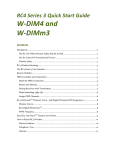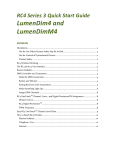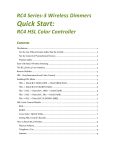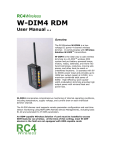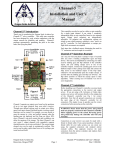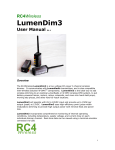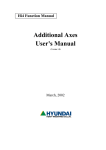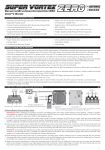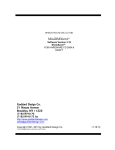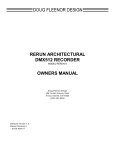Download Quick Start:
Transcript
RC4 Wireless RC4 Series-3 Wireless Dimmers Quick Start: Hobby Servo Motor Control Including: Assigning DMX channels to dimmers/drivers Setting motor direction Using RC4 OneTouchTM to do all of this with one press of a single button for each output RC4 Series-3 Quick Start: Hobby Servo Motor Control Disclaimers WIRING AND INSTALLATION OF BATTERIES, DIMMERS, AND LOADS MUST BE IN ACCORDANCE WITH APPLICABLE LOCAL AND NATIONAL ELECTRICAL CODES. RC4 Wireless devices and equipment are operated at the user’s own risk and RC4 Wireless accepts no liability, either direct or consequential, as a result of using this equipment. Not for Use Where Human Safety May Be At Risk RC4 Wireless accepts no liability for direct, indirect, or consequential damages resulting from the use of any RC4 Wireless product or group of products. RC4 Wireless does not guarantee the suitability of any product for any purpose; user assumes all risk. RC4 dimmers must be used strictly in accordance with manufacturer's instructions and cannot be used for unsupervised operation. RC4 Wireless products must be installed and operated only by qualified technicians, as outlined in the manufacturer's documentation, and should be inspected and tested on a regular basis to ensure proper and safe operation. Not for Control of Pyrotechnical Devices RC4 Wireless products should not be used to control pyrotechnics of any kind. A brief output surge on dimmer outputs during power-up could trigger these devices. RC4 Wireless accepts no liability if RC4 equipment is used for this or any other purpose. Product Safety RC4 receiver/dimmers are capable of controlling very large currents at up to 35VDC. Dimmers should not be allowed to operate at dangerous temperatures. Appropriately sized wire and connectors must be used, along with suitable ventilation to dissipate heat, and external fuses rated for the load being operated. This guide is not intended to provide comprehensive electrical safety instructions. RC4 devices should be used only by qualified personnel. Page 2 RC4 Series-3 Quick Start: Hobby Servo Motor Control RC4 Wireless Dimming If you are unsure about what wireless dimming can be used for, explore expert examples with pictures and information at www.wirelessdimming.com. Highlights include The Rockettes, Katy Perry, Wicked – The Musical, The Who’s Tommy, and much more. Tutorial videos to help you use and understand RC4 technology are available at http://www.theatrewireless.com/category/support/video/. Seeing the process is sometimes easier than reading a manual. Wireless dimming and servo motor control, with professional and reliable results, is easy – it’s easier than you think! DMX Controller and Transmitter RC4 Wireless devices are DMX controlled. You need a DMX controller (sometimes called a DMX Console, or a DMX Desk) to get started. If you’re setting up in a theatre space, you probably have a DMX controller in the lighting booth. You need a wireless DMX transmitter. The most common transmitter for an RC4Magic system is an RC4Magic DMXio. You can also use an RC4MagicPC dongle and Windows software. The software and additional information can be downloaded at http://www.theatrewireless.com/download/. Make the DMX Connection Connect a DMX data output from your DMX controller to the DMX data input on your wireless DMX transmitter. Be sure your transmitter is powered on and operating. In most cases, that’s all you need to do. Your DMX universe will now be out on the airwaves. Page 3 RC4 Series-3 Quick Start: Hobby Servo Motor Control Battery and Servo Motor(s) RC4 Series 3 devices have a wide voltage input range: 6V – 35VDC. Connect a battery or DC power supply within this range to the Vin terminals and the device will power on. If you are using a 4servo device, the power switch must also be ON, and a working fuse must be inserted All RC4 Wireless DC power inputs are protected against reverse polarity. If you connect the battery backwards, nothing will happen. It is difficult to protect dimmer and driver circuits from power connected to the output terminals. Do NOT do this! Connect your battery or power supply ONLY to the Vin terminals. Most hobby servo motors from Futaba, HiTec, JR Radios, Airtronics, and others can be controlled with RC4 Series 3 dimmers. The standard control signal is a repeating pulse, with full range of motion represented by pulse widths from 1ms to 2ms. A 1.5ms pulse normally positions a hobby servo motor in the center of travel. Servo motors operate on a range of voltages, most commonly 6V and 7.2V. You must use a battery that delivers an appropriate voltage for your servo. Some high-power servos operate at 12V or even higher. As noted previously, RC4 Series 3 devices work from 6V to 35V. The RC4 DMX4servo, LumenDim4servo, and W-DIM4servo provide four 3-pin outputs suitable for direct connection to most Futaba, HiTec, and JR servos. The pin-out is: 1. Control 2. Power (+V) 3. Ground (Common, or –V) Pin 1 is the pin closest to the fuse and power-switch on the 4servo device. Pin 3 is closest to the small DMX miniplug at the other end of the device. Always confirm the pin-out of your servo before connecting it. In some cases, wiring must be changed or an adaptor must be used, particularly with Airtronics servos which are often Power, Ground, Control. All RC4 Series 3 dimmers can be used for servo control with appropriate wiring and connectors. In this case, connect the servo motor +V (usually red) and –V (usually black) to the same battery that is powering the RC4 Series 3 device. Connect the servo signal line (usually yellow or white) to the negative output terminal of an RC4 dimmer (-DimA, -DimB, -DimC, or –DimD). Do not connect anything to the positive dimmer output terminal. Page 4 RC4 Series-3 Quick Start: Hobby Servo Motor Control Pairing Receivers with Transmitters New RC4 Series 3 units are shipped with dimmers in sequential order, starting at DMX channel 1. You can restore any RC4 Series 3 device to factory default settings: press and hold the recessed Func button while you press and release the SetA recessed button. DimA will blink, and all settings will be cleared to defaults. This job is easiest with two bent paperclips, one for each button. Every RC4Magic system has its own set of three unique Digital IDs, plus one Public ID that is the same on every RC4Magic Series 2 and Series 3 device ever built. Read the labels on the devices to confirm that they are programmed with at least one ID that is the same for all units. All devices within a single system must be set to the same ID. If you are setting up a new RC4Magic system for the first time, all of this is taken care of for you – everything is ready to go, plug-and-play, right out of the RC4 box. No special steps are required: your devices are already paired, secure, and ready to use in the most demanding situations. RC4Magic dimmers can take up to 15 seconds (usually much less) to connect with the transmitter. When the connection is established, the blue RF connect indicator will begin flashing and the yellow RF data indicator will blink or shimmer with incoming data packets. Make a Motor Move! If you are using a 4servo device, connect your battery and servo motor(s) as described above. If you are starting with one servo motor by itself, plug it into the A output. Ensure the battery is charged and the device is powered on. Connect your lighting controller to your DMXio transmitter. Ensure both are powered on. Fade DMX channel 1 up and down. The servo motor on output A of the 4servo device will spin back and forth, tracking the position of the DMX fader. If you are using any RC4 Series 3 device other than a 4servo, you must enable servo control by using RC4MagicPC or RDM (DMX Remote Device Management) and selecting the Servo CW or Servo CCW dimmer curve on the dimmer that is connected to a servo motor. Page 5 RC4 Series-3 Quick Start: Hobby Servo Motor Control Assign DMX Channels and Response Curves on 4servo Devices You probably don’t want to run all your servo motors on DMX channels 1 through 4. RC4 OneTouchTM makes it easy to assign a specific DMX channel and servo direction to any 4servo output with a single press of a single button. You need a working DMX controller and transmitter, and a bent paperclip or other small tool for pressing recessed buttons. OneTouch cannot be used to assign the Servo CW or Servo CCW dimmer curve on an RC4 Series 3 device other than a 4servo. This is because OneTouch can only resolve 4 different curves, which are reserved for ISL Slow, ISL Fast, Linear, and Non-Dim for lighting. Use RC4MagicPC or RDM to assign DMX channels and select any available curves, including Servo CW and Servo CCW curves. Start by clearing all your DMX channels to zero on your controller. Be sure this includes any “special” channels, like house lights and work lights, and be sure you are not using fixture profiles that “home” some channels at levels other than zero. For example, some moving light fixture profiles will send X and Y motion to a midpoint when the console is “cleared.” That midpoint is not zero; for RC4 purposes, you need actual zero. If you are unsure if all channels are really at zero, check your DMX line with a tester, like a Goddard DMXter or a Fleenor Gizmo. These are very handy devices to have around, for all kinds of reasons. Now, bring up the level of one DMX channel – any channel you like – to 30% (if you can’t decide, try channel 9, or channel 398). If you’re using a simple fader, put it about 1/3 of the way up. Next, go to a connected RC4 Series 3 4servo device and press the SetA button. If you have a servo motor connected, it will spin to the position represented by the DMX fader on your controller. When you let go of the button, the motor will stay in position. It is now assigned to the channel you have up. This level selects the Servo CW response curve. To run the servo motor in the opposite direction, set the DMX channel at 70%, instead of 30%. If you’re using a simple fader, put it about 2/3 of the way up. Press the Set button to select the Servo CCW response curve. Fade the channel up and down from your DMX controller. The servo motor will track it. It will remember your channel assignment and response curve until you change them. Page 6 RC4 Series-3 Quick Start: Hobby Servo Motor Control Setting the channel to 30% (anywhere from 20% to 50%) tells the 4servo device to use the Servo CW curve, where the lowest DMX level produces a 1ms pulse and the highest level produces a 2ms pulse; pulses get longer as the channel level increases. A setting of 70% (anywhere from 51% to 100%) tells the 4servo device to use the Servo CCW curve, where the lowest DMX channel level produces a 2ms pulse and the highest channel level produces a 1ms pulse; pulses get shorter as the DMX channel level increases. See the complete RC4 Series 3 Low-Voltage Wireless Dimmers User Manual for all the details you need to make the most of the best wireless dimmers in the world. Did we mention easy? RC4 Wireless has made wireless dimming easy since 1991. Page 7 RC4 Series-3 Quick Start: Hobby Servo Motor Control How to Reach RC4 Wireless Physical Address RC4 Wireless is a registered trade-name of Soundsculpture Incorporated of North Carolina. Soundsculpture Incorporated / RC4 Wireless 13604 Heathwood Court Raleigh, NC, 27615 USA Telephone / Fax Toll Free 1-866-258-4577 (North America) North Carolina, USA, Local 919-229-9950 London, UK +44 (0)20 3289 8765 Emergency Cellular 919-400-3961 Toll Free Fax 1-866-237-6641 (North America) Internet Email [email protected] Skype rc4acw Website www.theatrewireless.com If you like your RC4 Series 3 device, please take the time to let others know. Post information about your shows and productions at: www.theatrewireless.com/customers/submit-your-project/ Like us on Facebook, and check out helpful tips we post from time to time: www.facebook.com/RC4Wireless Follow us on Twitter for news about coming events and RC4 discount offers: www.twitter.com/RC4Wireless Page 8 RC4 Series-3 Quick Start: Hobby Servo Motor Control RC4Magic Series 3 Hobby Servo Motor Control User Manual v1.0 USA Sep 2014 © 2014 Soundsculpture Incorporated / RC4 Wireless Page 9









